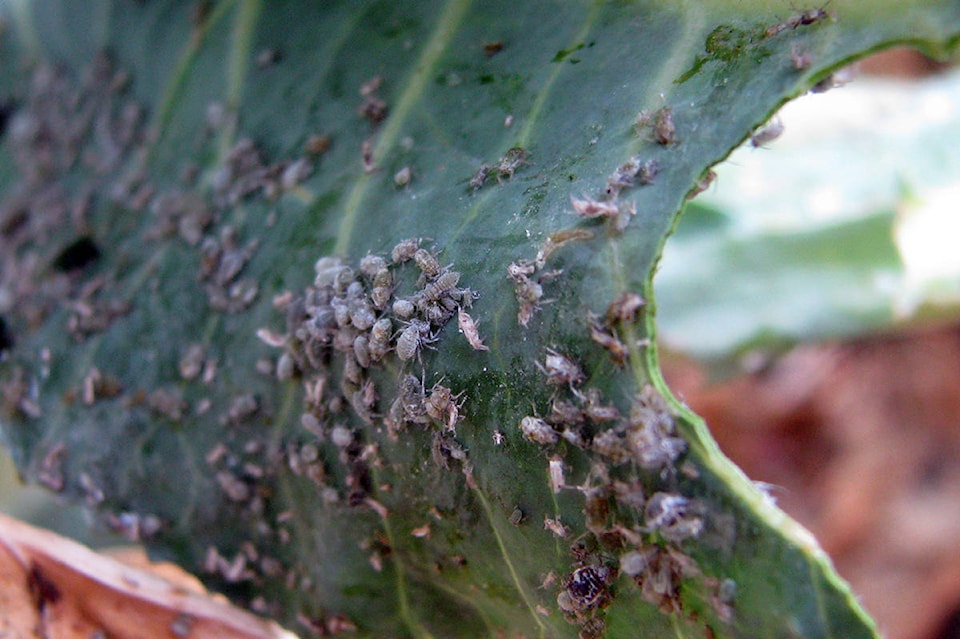Leslie Cox
Special to The Record
Oh, nuts. Aphids on my ‘Little Prince’ eggplant seedling. This may not be good.
There are reasons why aphids are the dearth of gardeners…the queen of pests…the death of some plants. Right at the top of the list, aphids are an extremely successful breed of organism.
Did you know aphids reproduce asexually as well as sexually? In spring, fully mature female aphids emerge from overwintered fertilized eggs, all set to reproduce from the get-go without the help of any males. (This is called parthenogenesis.) Combine this with an aphid’s ability to develop an embryo inside its body and give live birth to a young nymph, thus skipping the egg-laying stage, and you begin to understand how an instant population explosion can quickly develop on one poor plant. Especially since this pest is only between 0.04 and 0.39 of an inch in size and huge numbers have no problem living stacked on top of one another.
Depending on region, a generation of aphids can live anywhere from 20 to 40 days, and there can be multiple generations produced in a single season. Scientists have determined a single female cabbage aphid, Brevicoryne brassicae, is quite capable of producing more than 40 generations of females in a growing season. Doing the math – multiple females all producing 40-odd generations of reproductively active females – and you can see where the poor farmer or gardener can quickly lose an entire crop of cabbages.
Predators to the rescue of infested cabbages? Think again. Cabbage aphids emit a strong mustard oil scent that repels predators such as ladybugs and lacewings. They have also developed a defence by storing and releasing certain chemicals that can instigate violent reactions in predators.
Unfortunately, I have only touched the very tip of the aphid iceberg here. There are roughly 4,400 species worldwide which have been catalogued and named. Of these, 250 or so species are seriously detrimental agricultural and horticultural pests.
A gardener’s best line of defence against an aphid infestation is to hit the plant, or plants, with a strong jet of water from the hose. And do this repeatedly over several days in order to “catch” them all. You can also make up a soap/oil/water mixture and spray the entire plant, although this treatment is a little mind-boggling when dealing with large-sized plants or rows of cabbages in the field. Be mindful that while the soap and oil works well on coating and thus smothering aphids, it will also smother any soft-bodied beneficial insects in the vicinity.
Enough doom and gloom! Time to talk about the garden and there is no other way to say it: I am in awe. Give the plants a few days of sunshine with warm temperatures and things are literally popping. In one week the leaves on the chestnut tree have burst their buds and are almost full size. My hostas have broken ground and are displaying lovely furled leaves. (I know! Many of yours are in full leaf by now.)
What a treat to walk out the door and be embraced in delicious scent…at least when the breeze is right. The “culprits” are my Osmanthus delavayi (sweet olive) and Skimmia japonica (Japanese skimmia). It is also nice they are both evergreen shrubs, contributing much to the winter garden scene.
Colour is fast becoming almost riotous in numerous beds. Right now, down by the pond, Daphne cneorum (rose daphne) is a perfect backdrop for the flowers on Bergenia cordifolia ‘Rotblum’ (Red Bloom heartleaf bergenia, also known as pig-squeak because of its waxy leaves).
And speaking of the pond, we have spotted four black baby koi! Life goes on in the garden.
Homemade aphid spray recipe: Combine one quart (1 L) water, one tbsp (15 ml) dishsoap, and one tsp (5 ml) cooking oil in a spray bottle. Shake well and spray infested plant every day to kill all aphids.
Leslie Cox co-owns Growing Concern Cottage Garden in Black Creek. Her website is at www.duchessofdirt.ca and her column appears every second Thursday in the Record.
